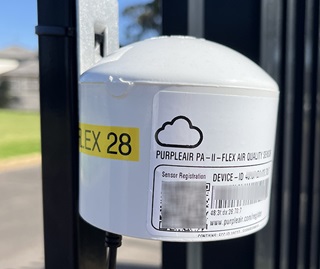 Different types and brands of low-cost sensors exist, such as PurpleAir, Koala and Luftdaten.
Different types and brands of low-cost sensors exist, such as PurpleAir, Koala and Luftdaten.
The department uses low-cost sensors during incident monitoring to complement the NSW air quality monitoring network. These sensors give a good indication of localised particle pollution, but they don't identify the source or composition of dust.
About PurpleAir sensors
The PurpleAir is a low-cost sensor created by a grassroots organisation in the United States of America, primarily to fill gaps across compliance monitoring networks.
Purple Air sensors measure airborne particulate matter (PM). Particulate matter describes solid particles suspended in air, including dust, smoke, pollen, and other organic and inorganic particles. The sensors use laser particle counters that count particles in the air in a range of sizes. These particle counts are then used to estimate the PM2.5 air quality index (AQI).
Measurements are recorded to an SD card and uploaded continuously to the cloud over Wi-Fi. PurpleAir instruments are powered via a micro-USB port, requiring a small external power source.
Data provided by the sensors on this map can be impacted by smoke from BBQs, wood heaters, extraction fans and air conditioners. When foggy, the sensors may measure water droplets in fog as particles, giving an incorrect reading.
PurpleAir sensors data is made available to the public in real-time via an interactive map.
How to use the PurpleAir interactive map
Two settings must be selected when using the PurpleAir interactive map: the data layer and the conversation. Both settings are important for different reasons.
- Apply conversion: converts the raw ug/m3 from Purple Air into a ug/m3, which is closer to what is measured by compliance methods. It factors in the humidity reading and tries as best as possible to approximate it to the measurements in ug/m3.
- Data layer: represents what colour scale to use on the map. We recommend selecting the 'Tasmanian PM2.5 scale' or the 'Australian PM2.5 scale' for the best results.
Completing standard air quality monitoring instruments
Low-cost sensors are designed to assess air quality in a more accessible way for the public than standard air quality monitoring instruments. These sensors are very useful in reporting current air quality to the community but are not certified for monitoring for legislative purposes.
Compared to the department's standard air quality monitoring instruments, low-cost sensors are smaller, less accurate, and function using different technologies.
Although low-cost sensors are not accurate enough to provide monitoring for legislative purposes, when used as a network, they provide feedback on short-term increased or decreased air pollution and relative exposure between locations.
Limitations and benefits
Low-cost sensors have several benefits: they are good value for money, are easy to deploy and maintain, and offer near real-time monitoring on an accessible cloud-based system (interactive map). In addition, PurpleAir sensors possess 2 optical sensors, which assures data quality.
However, low-cost sensors occasionally report questionable data points due to bias resulting in over- or under-estimates of pollutant concentration. Moreover, inaccurate readings can be caused by temperature changes or high humidity levels. Low-cost sensors are also sensitive to technology malfunctions, power supply interruptions, and weather interference.

